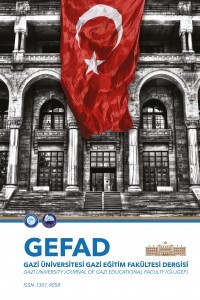WEB TABANLI PORTFOLYO OLUŞTURARAK ÖĞRETMEN OLMAK: ÖĞRETMENLİK UYGULAMALARI İÇİN PEDAGOJİK BİR MODEL
Bu makalede hizmet öncesi öğretmenlerinin yansıtma becerilerini geliştirmekte kullanılabilecek pedagojik bir model betimlenmektedir. Bu modele temel oluşturan görüş, yansıtma becerilerini esas alan uygulamaların profesyonel eğitimin anahtar öğesi olması gerektiği görüşüdür. Önerilen pedagojik model çerçevesinde geliştirilen ve bu yönde özelleştilmiş bir web tabanlı portfolyo yazılımı olan BOUNCE tanıtılacaktır. Ayrıca, öğretmen adaylarının yansıtma becerilerinin gelişiminin değerlendirilmesinde kullanılabilecek olan yansıtma göstergeleri açıklanacak ve daha sonraki çalışmalar için önerilerde bulunulacaktır.
Anahtar Kelimeler:
Web-tabanlı portfolyolar; Yansıtma; Hizmetöncesi öğretmen eğitimi; Öğretmen öğrenmesinin değerlendirilmesi
LEARNING TO TEACH WITH WEB-BASED PORTFOLIOS: A PEDAGOGICAL MODEL FOR PRESERVICE TEACHER EDUCATION
This paper describes a teaching practicum pedagogical model that can be used to improve preservice teachers\' reflective skills. The model primarily draws upon the idea that reflective practicum should be the key element of professional development. A customized web-based portfolio system, namely BOUNCE, that was designed based on the proposed pedagogical model is introduced. In addition, reflective indicators that could be used to assess the development of preservice teachers\' reflective skills are articulated, and suggestions for further research are included.
Keywords:
Web-based portfolios; Reflection; Preservice teacher education; Assessment of teacher learning,
___
- Ayers, W. (2001). To teach: The journey of a teacher. New York: Teachers College Press.
- Barnes, H. (1989). Structuring knowledge for the beginning teacher. In M. C. Reynolds (Ed.), Knowledge base for the beginning teacher (pp. 13-22). New York: Pergamon Press.
- Bird, T. (1990). The schoolteacher’s portfolio: An essay on possibilities. In J. Millman ve L. Darling-Hammond (Eds.), Handbook of teacher evaluation: Elementary and secondary personnel (2nd ed., pp. 241-256). Newbury Park, CA: Sage.
- Borko, H., Michalec, P., Timmons, M., & Siddle, J. (1997). Student teaching portfolios: A tool for promoting reflective practice. Journal of Teacher Education, 48(5), 345-3
- Cambridge, B. (2001). Electronic portfolios as knowledge builders. In B. L. Cambridge, S. Kahn, D. P. Thompkins, ve K. B. Yancey (Eds.), Electronic portfolios: Emerging practices in student, faculty, and institutional learning (pp. 1-11). Washington, DC: American Association of Higher Education.
- Cochran-Smith, M. (2004). The problem of teacher education. Journal of Teacher Education, 55(4), 295-299.
- Dana, T. M., & Tippins, D. J. (1998). Portfolos, reflection and educating prospective teachers of science. In B. J. Fraser ve K. G. Tobins (Eds.), International handbook of science education (pp. 719-732). Dordrecht, Netherlands: Kluwer Academic.
- Darling, L. F. (2001). Portfolio as practice: The narratives of emerging teachers. Teaching and Teacher Education, 17(1), 107-121.
- Dreyfus, H. L., & Dreyfus, S. E. (1986). Mind over machine: The power of human intuition and expertise in the era of the computer. New York: The Free Press. Evans, S., Daniel, T., Mikovch, A., Metze, L., & Norman, A. (2006). The use of technology in portfolio assessment of teacher education candidates. Journal of Technology and Teacher Education, 14(1), 5-27.
- Fendler, L. (2003). Teacher reflection in a hall of mirrors: Historical influences and political reverberations. Educational Researcher, 32(3), 16-25.
- Freese, A. R. (1999). The role of reflection on preservice teachers' development in the context of a professional development school. Teaching and Teacher Education, 15(8), 895-909.
- Freese, A. R. (2006). Reframing one’s teaching: Discovering our teacher selves through reflection and inquiry. Teaching and Teacher Education, 22(1), 100-119.
- ISSN: 1301-9058
- Yayın Aralığı: Yılda 3 Sayı
- Başlangıç: 1985
- Yayıncı: Gazi Üniversitesi
